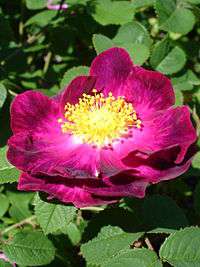Rosa gallica
| Rosa gallica | |
|---|---|
 | |
| Wild Rosa gallica in Romania | |
| Scientific classification | |
| Kingdom: | Plantae |
| (unranked): | Angiosperms |
| (unranked): | Eudicots |
| (unranked): | Rosids |
| Order: | Rosales |
| Family: | Rosaceae |
| Genus: | Rosa |
| Species: | R. gallica |
| Binomial name | |
| Rosa gallica L. | |
Rosa gallica, the Gallic rose, French rose, or rose of Provins, is a species of flowering plant in the rose family, native to southern and central Europe eastwards to Turkey and the Caucasus.
Description
Rosa gallica is a deciduous shrub forming large patches of shrubbery, the stems with prickles and glandular bristles. The leaves are pinnate, with three to seven bluish-green leaflets. The flowers are clustered one to four together, single with five petals, fragrant, deep pink. The hips are globose to ovoid, 10–13 mm diameter, orange to brownish.
Gallica group
Cultivars of the species R. gallica and hybrids close in appearance are considered as a cultivar group, the Gallica Group roses. Their exact ancestry is usually unknown and other species may be involved. The Gallica Group roses share the vegetative characters of the species, forming low suckering shrubs. The flowers can be single, but most commonly are double or semidouble. The colours range from white (rare) to pink and deep purple. All Gallica Group roses are once flowering. They are easily cultivated.
Apothecary's rose
Plants with semidouble deep pink flowers have been treated as either a variety, under the name R. gallica var. officinalis,[1] or as a cultivar, R. gallica 'Officinalis'.[2] It is also called the apothecary's rose, the crimson damask rose, or the red rose of Lancaster.[3] It is the county flower of Lancashire. A cultivar R. gallica var. officinalis 'Versicolor', with striped pink blooms, is also known as Rosa mundi.[4]
The names Rosa gallica f. trigintipetala or Rosa 'Trigintipetala' are considered to be synonyms of Rosa × damascena.[5]
Cultivation

The species is easily cultivated on well drained soil in full sun to semishade; it can survive temperatures down to −25 °C. It is one of the earliest cultivated species of roses, cultivated by the Greek and Romans and commonly used in mediaeval gardens. In the 19th century it was the most important species of rose to be cultivated, and most modern European rose cultivars have at least a small contribution from R. gallica in their ancestry.
The following cultivars and hybrids have gained the Royal Horticultural Society's Award of Garden Merit.
- 'Beau Narcisse' (Mielles <1824)[6]
- 'Belle de Crécy' (Roeser 1836; withdrawn)[7]
- 'Cardinal de Richelieu' (Parmentier <1847; withdrawn)[8] - this rose was used as a starting point for genetic engineering to produce the first blue rose
- 'Charles de Milles' (<1790)[9]
- 'Complicata'[10]
- 'Duc de Guiche' (<1810)[11]
- 'Duchesse de Montebello' (Laffay 1824)[12]
- 'Président de Sèze'[13]
- 'Officinalis'[14]
- 'Versicolor' ('Rosa mundi')[15]
- 'Tuscany superb'[16]
References
| Wikimedia Commons has media related to Rosa gallica. |
| Wikimedia Commons has media related to Rosa Hybrid Gallica. |
- ↑ RHS Horticultural Database: Rosa gallica var. officinalis, Royal Horticultural Society, retrieved 2011-07-24
- ↑ Phillips & Rix (2004), The Ultimate Guide to Roses : a comprehensive selection, London: Macmillan, ISBN 978-1-4050-4920-7
- ↑ RHS A-Z encyclopedia of garden plants. United Kingdom: Dorling Kindersley. 2008. p. 1136. ISBN 1405332964.
- ↑ "BBC plant finder - Rosa mundi". Retrieved 31 May 2013.
- ↑ Nomenclature listing for Rosa gallica forma trigintipetala from USDA GRIN
- ↑ "Royal Horticultural Society, 'Beau Narcisse'".
- ↑ "Royal Horticultural Society, 'Belle de Crécy'".
- ↑ "Royal Horticultural Society, 'Cardinal de Richelieu'".
- ↑ "Royal Horticultural Society, 'Charles de Milles'".
- ↑ "Royal Horticultural Society, 'Complicata'".
- ↑ "Royal Horticultural Society, 'Duc de Guiche'".
- ↑ "Royal Horticultural Society, 'Duchesse de Montebello'".
- ↑ "Royal Horticultural Society, 'Président de Sèze'".
- ↑ "Royal Horticultural Society, 'Officinalis'".
- ↑ "Royal Horticultural Society, 'Versicolor'".
- ↑ "Royal Horticultural Society, 'Tuscany superb'".
- Flora Europaea: Rosa gallica
- Huxley, A., ed. (1992). New RHS Dictionary of Gardening. Macmillan.
- Article on the use of RNAi technology to produce a blue rose
 'Alain Blanchard' (Vibert 1839)
'Alain Blanchard' (Vibert 1839) 'Ornament de la Nature' (Toutain 1826)
'Ornament de la Nature' (Toutain 1826)